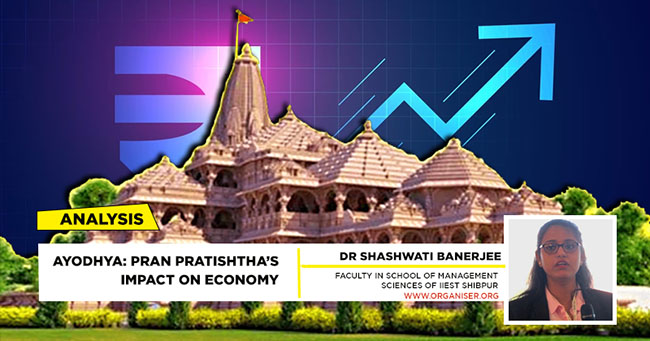The Pran Pratishtha of Ram Lalla at the Ram Mandir in Ayodhya embodies various economic and developmental theories, each contributing to its far-reaching impact. From an economic perspective, the construction of the Ram Mandir aligns with classical economic theories, which posit that investments and capital injections stimulate economic growth. The funds directed towards the temple’s construction can have multiplier effects, creating employment opportunities and boosting demand for goods and services. This economic stimulus is particularly significant in the context of Ayodhya transforming into a pilgrimage destination, as religious tourism often brings substantial economic benefits to local communities.
The Pran Pratishtha of Ram Lalla in Ayodhya provides a unique opportunity to align with theories of sustainable development, cultural capital, institutional economics, and partnership theories, all contributing to the long-term economic and developmental goals set by the Sustainable Development Goals (SDGs). From a sustainable development perspective, the event can serve as a model for integrating eco-friendly infrastructure and conservation measures into the development plan. This aligns with sustainable economic growth principles, emphasising the importance of balancing economic progress with environmental stewardship. Additionally, Pran Pratishtha event holds significance in the context of cultural capital theories and institutional economics. Preserving cultural heritage and fostering an environment of peace and justice are integral components of sustainable development. Cultural assets, like the Ram Mandir, can serve as catalysts for economic growth by attracting tourists and generating revenue.
The collaborative efforts involving different stakeholders in the Pran Pratishtha align with partnership theories. The cooperation between Government bodies, private enterprises and local communities demonstrates the importance of collective action in achieving comprehensive economic and developmental goals. Such partnerships are vital for creating a conducive environment for economic growth, social progress, and the overall well-being of the community. As the event unfolds, Ayodhya has the potential to emerge as a beacon of sustainable development, cultural richness and collaborative governance, setting an example for other regions to follow in pursuit of the SDGs.
The discussion remains partial without the historical evidence from renowned religious sites worldwide, such as Mecca, the Vatican, and Bodh Gaya, which provides a scientific basis for understanding the economic impact of the Pran Pratishtha of Ram Lalla at the Ram Mandir in Ayodhya. The economic success observed around Mecca serves as a relevant example, showcasing how religious events and pilgrimage can stimulate economic growth. Another notable example is the Vatican in Rome, Italy. The Vatican, as the centre of the Roman Catholic Church, attracts millions of pilgrims and tourists annually. The economic impact is substantial, influencing various sectors such as hospitality, transportation, and local businesses. Additionally, Bodh Gaya in Bharat, where Gautama Buddha attained enlightenment, represents a case where religious significance has translated into economic development. Pilgrims from around the world visit Bodh Gaya, leading to increased economic activities in the local community. These examples support the scientific understanding that the Pran Pratishtha of Ram Lalla in Ayodhya has the potential to trigger economic benefits for the region, drawing parallels with historical instances of economic prosperity around religious sites. The historical successes of these religious sites affirm the scientific principle that cultural and religious events can be potent catalysts for economic expansion, supporting the notion that the Pran Pratishtha in Ayodhya has the potential to generate similar positive economic outcomes through increased tourism, job creation, and overall socio-economic development. In conclusion, the Pran Pratishtha of Ram Lalla at the Ram Mandir has the potential to be a transformative force, aligning with multiple SDGs and echoing the historical successes of religious sites in fostering economic growth. By integrating sustainable practices, preserving cultural education, and fostering peace and justice, Ayodhya can emerge as a model for inclusive and sustainable development, setting a precedent for future endeavours.



















Comments